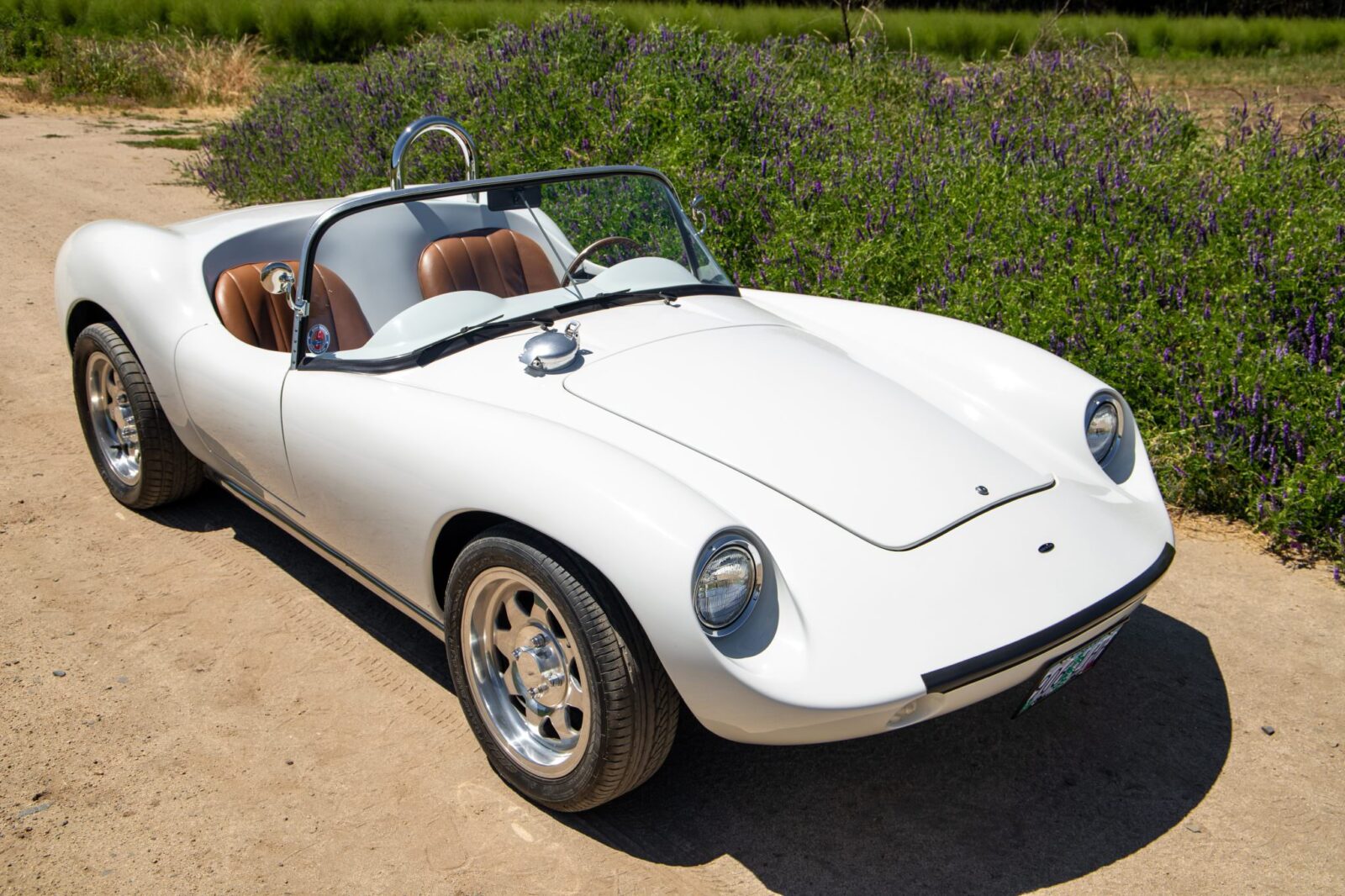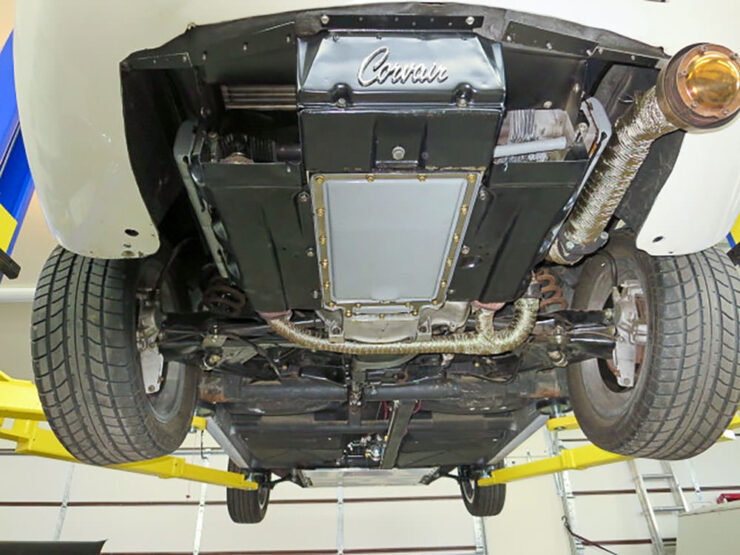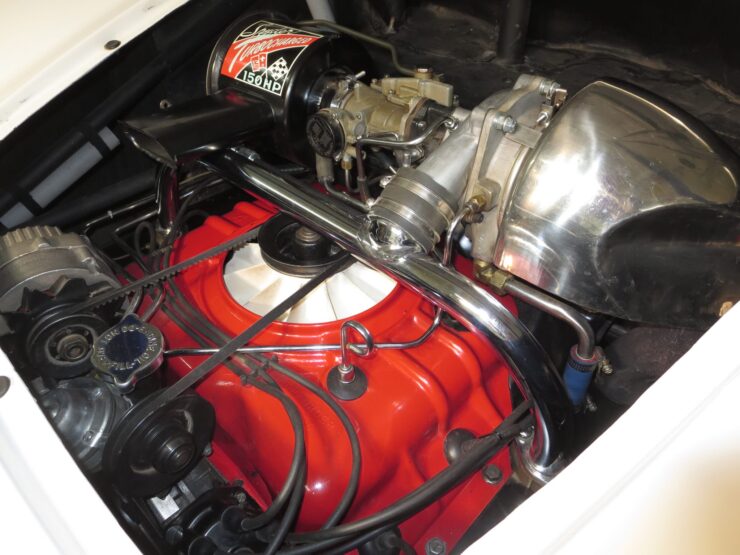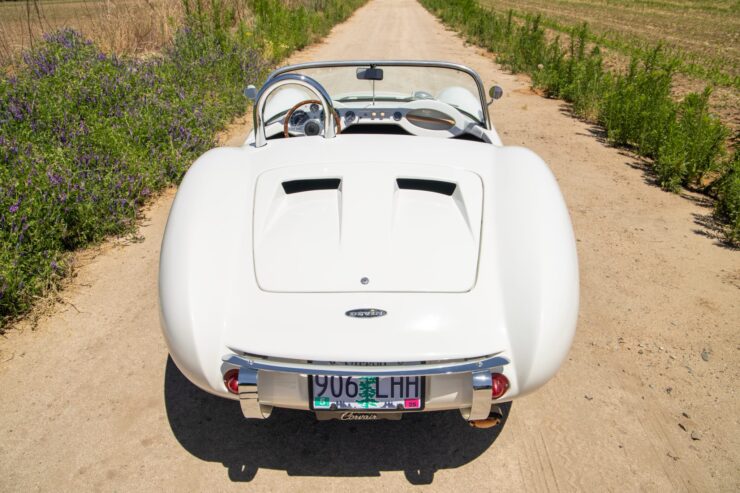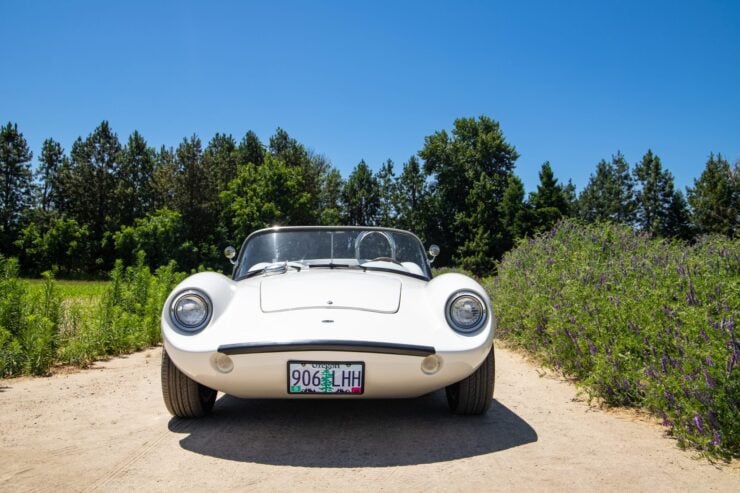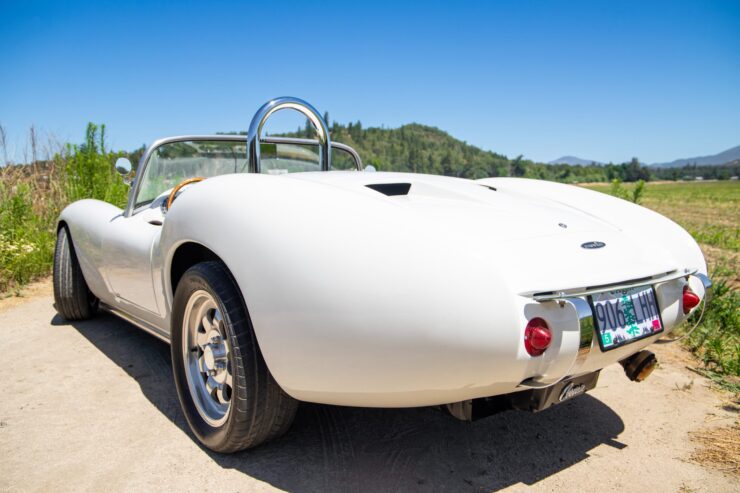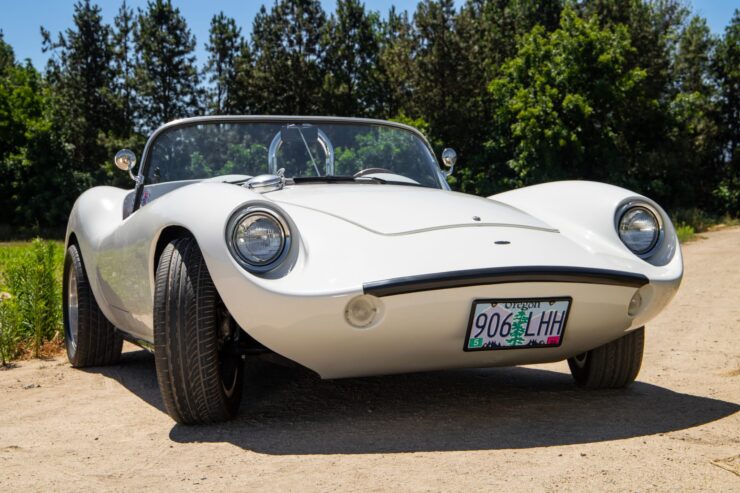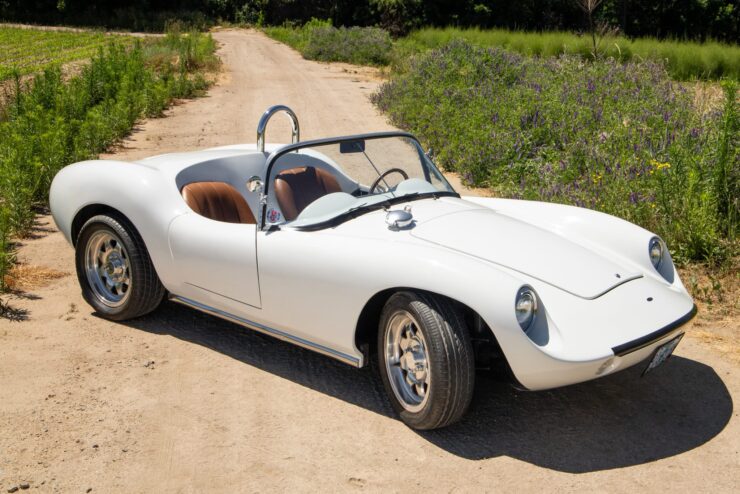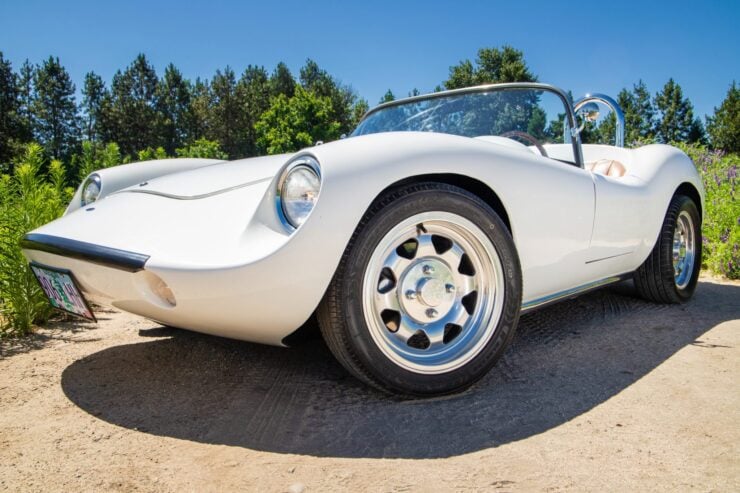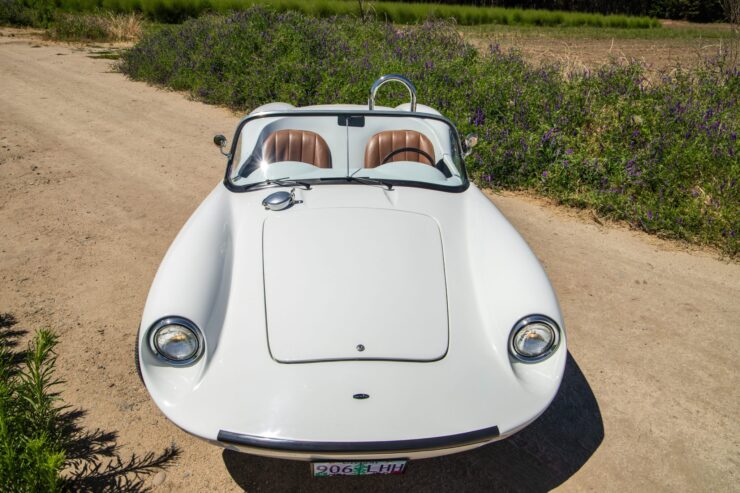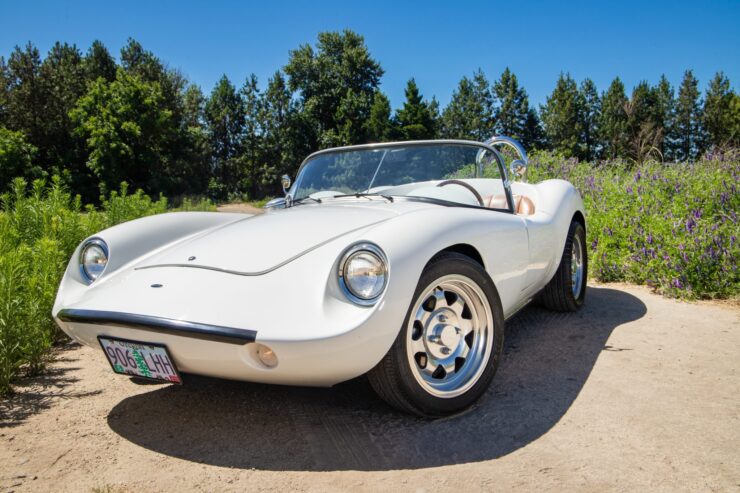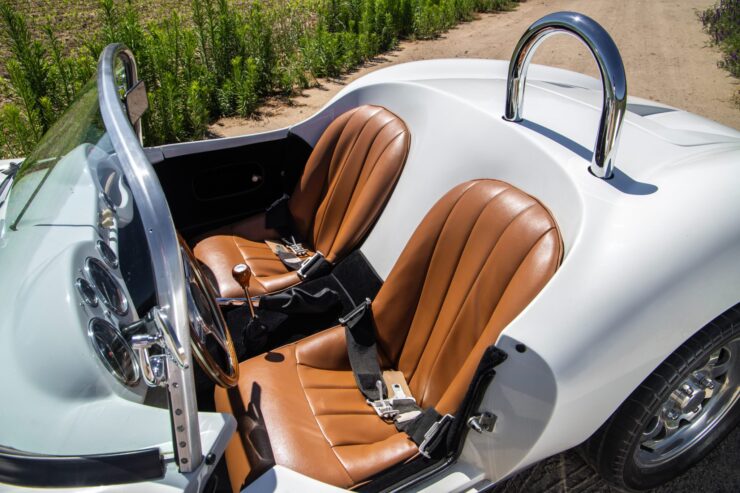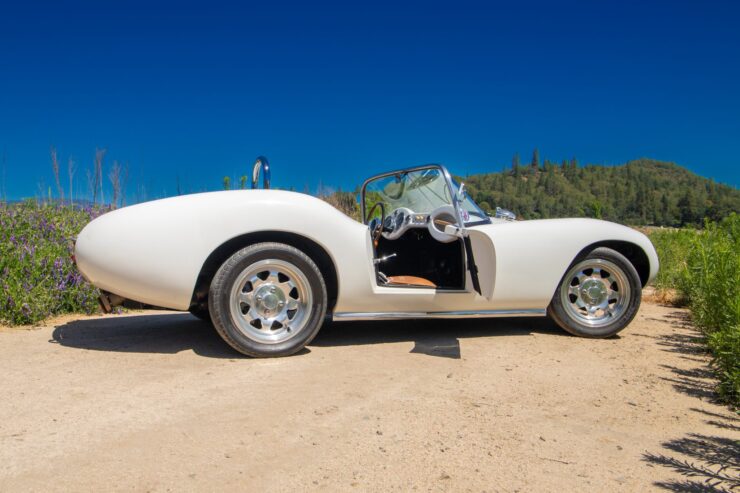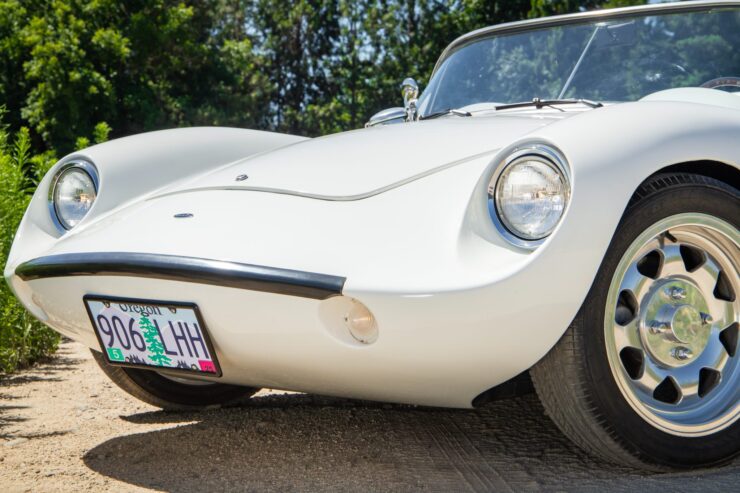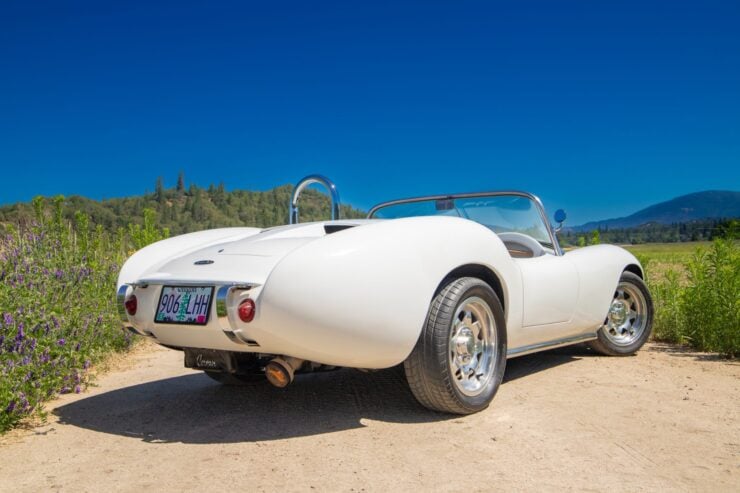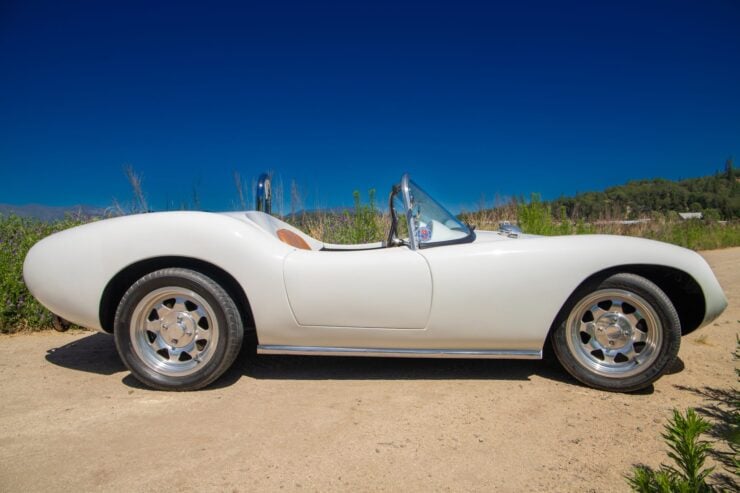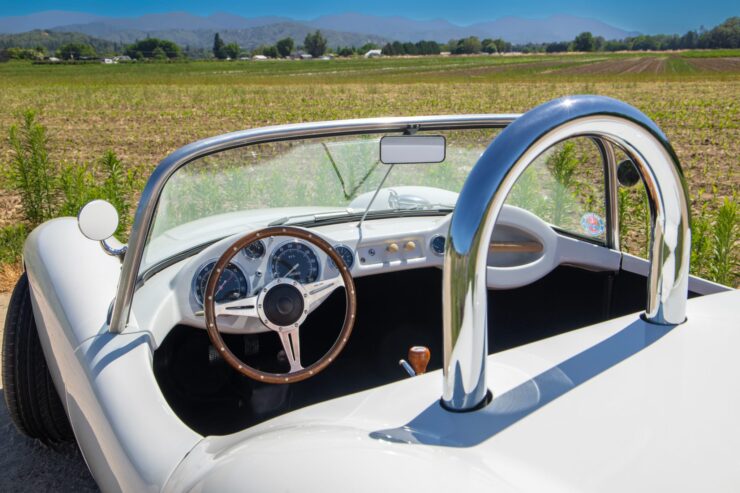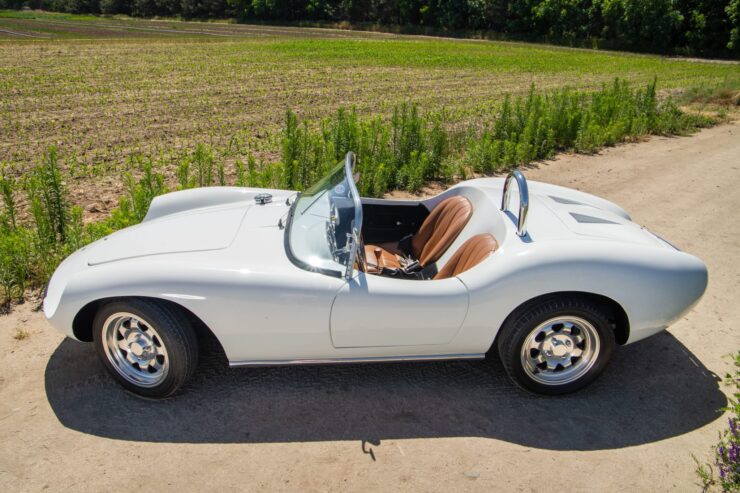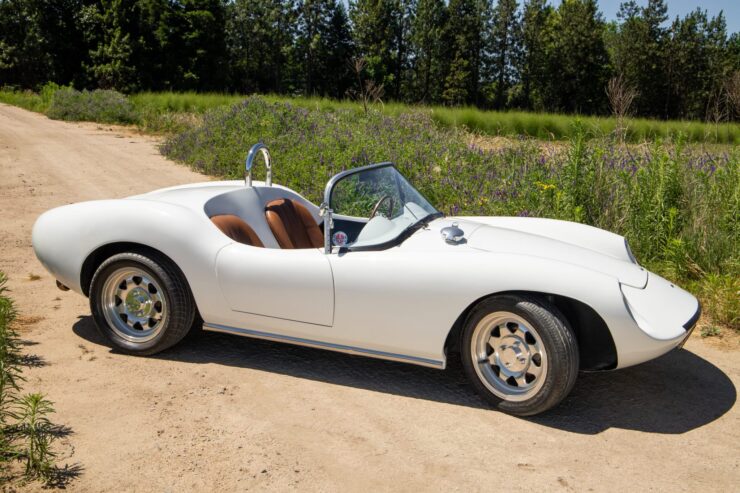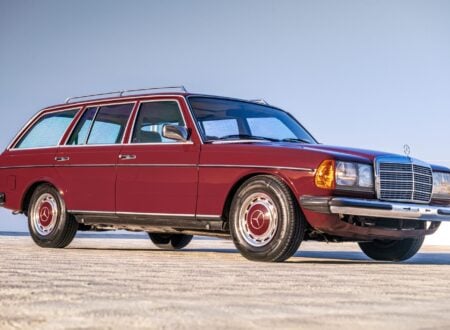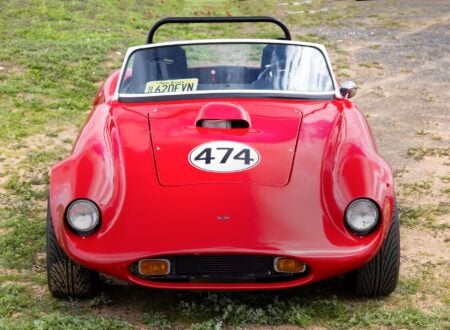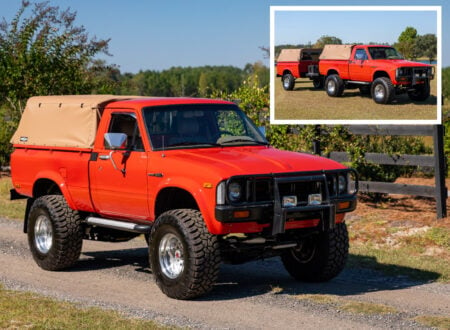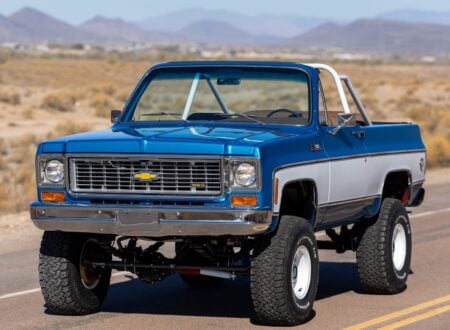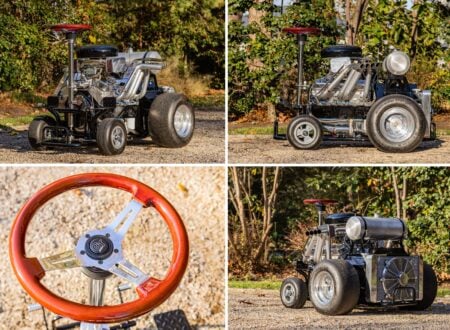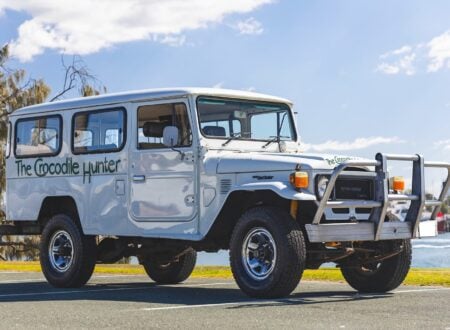This is one of three Devin C roadster prototypes that were built and it’s powered by a turbocharged flat-six sourced not from a Porsche 911, but from a Chevrolet Corvair.
Interestingly, this car would be the first turbocharged vehicle to race in the Pikes Peak Hill Climb, taking seventh place among the 12 competitors that year. The car is now in restored condition with its original engine in place, and it’s being sold out of 53 year ownership.
Fast Facts – The Turbocharged Devin C Prototype
- This Devin C prototype was one of three built, featuring a turbocharged Chevrolet Corvair flat-six engine. It was the first turbocharged vehicle to race in the Pikes Peak Hill Climb, finishing seventh out of 12 competitors in 1962. The car is now restored with its original engine.
- Bill Devin, the car’s designer, was a racing driver and innovator who invented the automotive timing belt. He founded Devin Enterprises in 1955, producing fiberglass bodies, kits, and complete sports cars. His modular fiberglass body design allowed for 27 different sizes to fit various chassis wheelbases and widths.
- The Devin C was based on the earlier Devin D platform, modified to accept the Chevrolet Corvair flat-six engine. It was available as a kit or turnkey car, weighing only 1,380 lbs at the curb. The turbocharged Spyder engine option, introduced in 1962, offered 150 bhp and over 200 lb ft of torque.
- Only 25 Devin C cars were built by the factory between 1959 and 1965. This particular prototype raced at Pikes Peak, was owned by a dairy farmer, and spent 27 years in storage before restoration. It’s now being offered for sale with historical photos and documentation.
Bill Devin “The Enzo Ferrari of the Okie Flats”
Bill Devin is one of the unsung heroes of the mid-20th century American automotive world. He was a successful racing driver, he started his own automobile company, and perhaps most notably – he’s the guy who invented the automotive timing belt, a concept now used in countless millions of cars around the world.
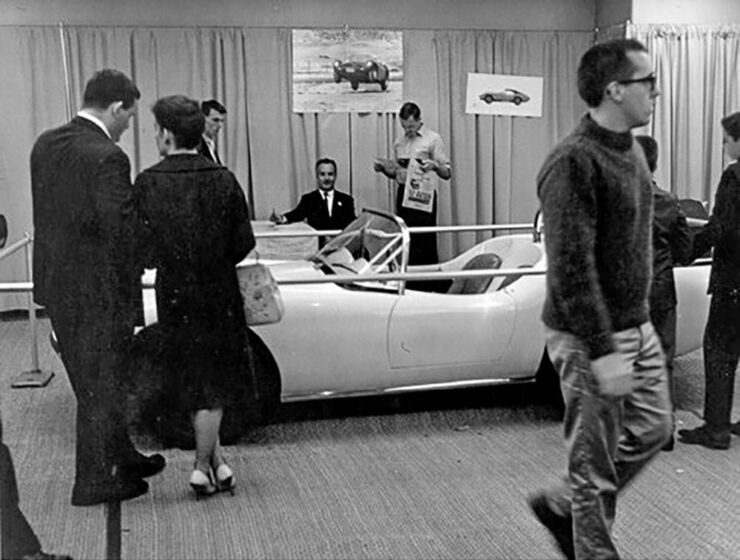 Bill Devin (seated at the desk) showing the Devin C at the 1962 New York Auto Show, this is the same car shown here in this article.
Bill Devin (seated at the desk) showing the Devin C at the 1962 New York Auto Show, this is the same car shown here in this article.Sadly for Bill, he didn’t patent his timing belt innovation. He had invented it simply because he needed a way of operating the overhead cams from a pair of Norton single cylinder barrels and heads after that had been grafted onto a two-cylinder Panhard boxer crankcase.
The Nortons originally used a shaft with bevel gears to drive the cam, but Bill realized that a toothed rubber belt would do a better job, and sap less power, so he had a new belt made for the application by a company that produced drive belts for agricultural machinery.
Bill Devin Goes Racing
In the sports car world, Bill Devin’s other claim to fame are the highly-competitive roadsters he designed and built starting in 1955 under the company name Devin Enterprises. The automotive trade was nothing new to Bill, he had been raised in a family that owned a Chevrolet dealership and mechanical workshop in Oklahoma.
After serving in the US Navy during WWII, Bill would set up his own dealership, eventually owning a few of them, which helped fund his early forays into amateur racing. He would win his first ever race driving a Crosley that he had modified himself in 1950 at Buchannan Field California.
Before long he would be driving Ferraris, even sharing a car with future Formula One World Champion Phil Hill at a number of meets in California.
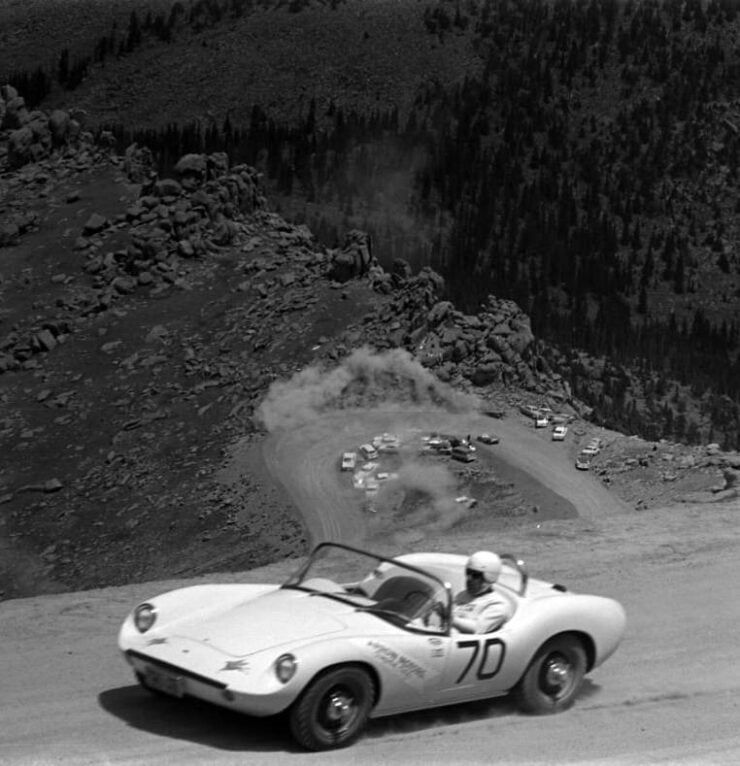 Here we see the car competing at the 1962 Pikes Peak Hillclimb with Pete Woods at the controls. Image courtesy of the Pikes Peak International Hillclimb.
Here we see the car competing at the 1962 Pikes Peak Hillclimb with Pete Woods at the controls. Image courtesy of the Pikes Peak International Hillclimb.Bill Starts Building His Own Cars
As a talented welder, fabricator, and mechanic, it wasn’t long before Bill decided he could do better, and he set to work designing and building his own sports racing car.
He fabricated a chassis that would fit a new fiberglass body he had developed using a Deutsch-Bonnet as a reference. Fiberglass has been called the carbon fiber of the 1950s, it was strong, lightweight, easy to use, and impervious to rust.
Ever the entrepreneur, Bill designed a fiberglass body that was modular – he almost certainly the first person in the world to do so. His fiberglass body molds consisted of 50 sections that allowed him to produce the Devin body in up to 27 different sizes – to fit a variety of chassis widths and wheelbases.
The Devin bodies would be advertised in the back of car magazines and sold to people across the United States, many of whom worked for years in the garages to fit the body over their donor chassis and get their custom car on the road.
The End Of Devin – And A New Beginning
Devin Enterprises would remain in business from 1955 until 1965, it was one of the biggest companies of its kind at the time, producing fiberglass bodies, fiberglass body and chassis kits, and completed turnkey sports cars.
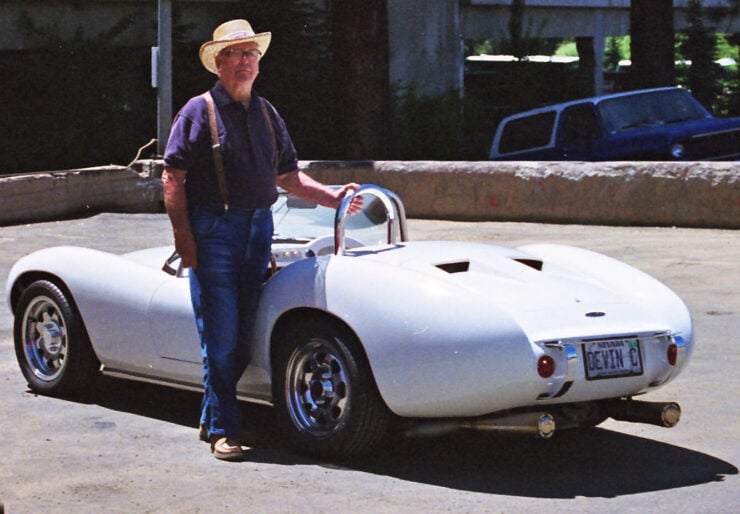 This is Bill Devin with the car in 1999, 37 years after he displayed it at the New York Auto Show.
This is Bill Devin with the car in 1999, 37 years after he displayed it at the New York Auto Show.This wouldn’t be the end of Devin though, the company was revived as Devin Sports Cars of Abington, Pennsylvania in recent years, providing parts and expertise to Devin owners around the world.
The Turbocharged Devin C Prototype Shown Here
The car you see here is arguably one of the most historically signifiant Devins ever made. As noted in the introduction, this was the first turbocharged car to ever compete in the Pikes Peak Hillclimb, finishing seventh out of the 12 competitors in 1962.
The Devin C was developed on the earlier Devin D platform, it was modified specifically to accept the then-new Chevrolet Corvair flat-six – a rear-mounted, air-cooled engine that debuted in the Corvair model in 1959. That was five years before Porsche unveiled their own flat-six-powered car – the Porsche 911.
When ordering you Devin C you could opt to have it delivered as a kit which you would then assemble yourself, or you could order it as a turnkey car. Most buyers choose the former, and as a result there is quite a bit of variance in the looks and specifications of the completed cars.
The kit included a tubular steel chassis and the parts for the fiberglass body, as well as countless other smaller parts required for the build. The kit builder would then need to source their own Corvair engine and transmission, the rear suspension and brakes from the Corvair were included as part of the package.
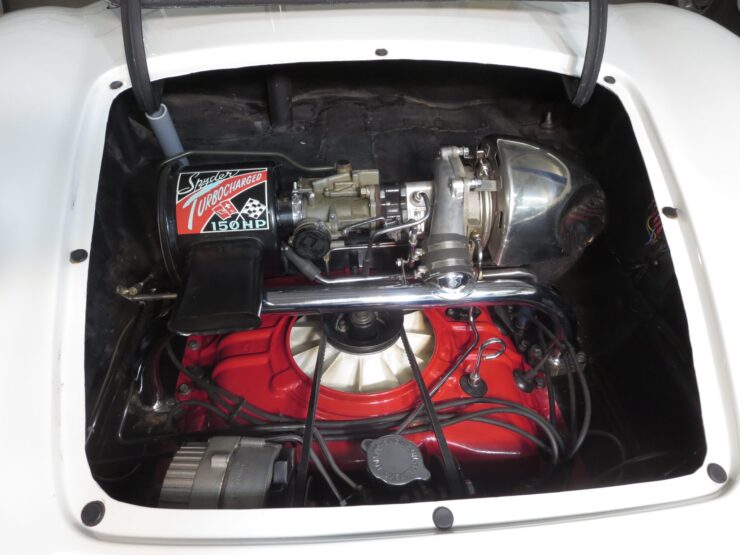 Under the rear engine lid of the car you’ll find a Corvair Spyder engine, a turbocharged flat-six with 150 bhp and 210 lb ft of torque.
Under the rear engine lid of the car you’ll find a Corvair Spyder engine, a turbocharged flat-six with 150 bhp and 210 lb ft of torque.The completed car weighed in at just 1,380 lbs (626 kgs), and the 2.4 liter Corvair engine was good for 80 bhp at 4,400 rpm and 128 lb ft of torque at 2,300 rpm. Chevrolet would continually upgrade the Corvair, with engine power climbing to over 100 bhp by the early-1960s.
In 1962 Chevrolet offered the Spyder engine option on the Corvair Monza coupe and convertible models, this included a turbocharged engine now capable of 150 bhp and 210 lb ft of torque. This performance transformed the car, and interestingly Chevrolet would send a Spyder engine over to Devin for use in a Devin C.
Only 25 examples of the Devin C were built by the company between 1959 and 1965, it’s not known how many have survived to the modern day, or how many kit versions were sold and completed in addition to this number.
The car you see here is one of the original three prototypes, after its weekend at Pikes Peak the car ended up in the hands of a California dairy farmer who raced it at club events at Riverside Raceway before selling it to the current owner (and now seller) in 1971.
After this the car would remain in storage for 27 years. It would later be restored and have its bodywork repaired, it was repainted, and a naturally-aspirated Corvair engine was fitted. Fortunately the original turbocharged engine was kept and later rebuilt, then re-fitted to the car.
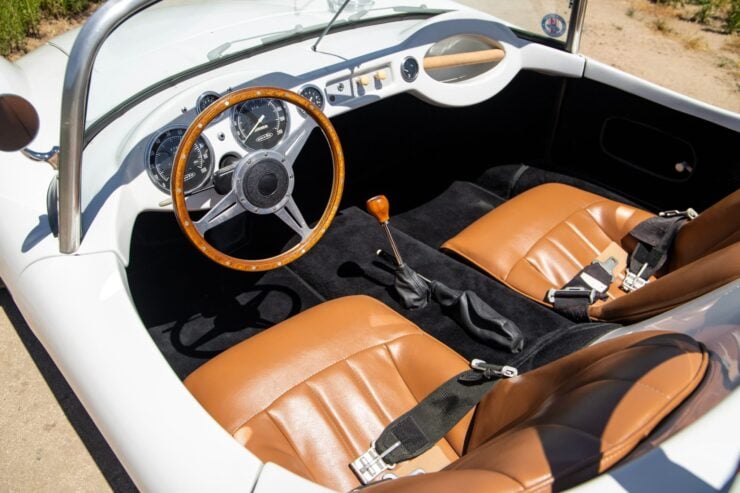 The interior of the car is very well put together, with a wood-rimmed steering wheel, black carpeting, tan upholstery, and lap belts for the driver and passenger.
The interior of the car is very well put together, with a wood-rimmed steering wheel, black carpeting, tan upholstery, and lap belts for the driver and passenger.It’s now being offered for sale on Bring a Trailer out of Grants Pass, Oregon. The car comes with a clean Oregon title in the seller’s name. It also comes with historical photos of the car including images of its participation in the 1962 Pikes Peak Hillclimb, its 1990s restoration, and its 2017 appearance at The Quail, as well as photos of Bill Devin with the car in 1999 (shown above).
If you’d like to read more about it, see more of the images, or register to bid you can visit the listing here.
Images courtesy of Bring a Trailer + The Pikes Peak International Hillclimb

